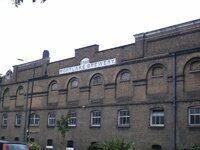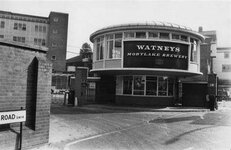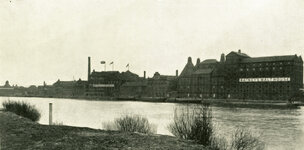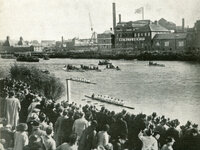Brewery tales
Joining
I had always enjoyed science based studies but the school and teachers I attended showed little interest except to show up, spew a lot of words, write on the blackboard and then go home. Looking back they were awful. There was no enthusiasm and they didn’t really care if we learnt anything.
Managed to get O levels in Chemistry, Physics and Biology plus a few others. Not maths as I am numerically dumb! I can do the basics but algebra and the other stuff just baffled me and teachers didn’t care (as I may have mentioned).
Had no idea of what career I wanted to take so went to the careers office and they sent me for an interview at a brewery! The same brewery my grandfather worked at. Got on the train and got ready to get off at the station only for it to not stop! Anyway, got back to the place and apologised profusely and got the job.
It was in the central laboratory for Watney, Mann and Truman (of Red Barrel fame – more on that later). They are no longer around. I also worked for TWA (no longer around), Coca-Cola Southern Bottlers (no longer around), Scottish Equitable (no longer around), seems to be a trend here. Only British Airways seems to have survived having me as an employee!
Each brewery had its own production lab to test brews through the production process but we at the Central Lab tested monthly samples of all the beer produced to make sure there was consistency between breweries and we also tested competitors products. We also did pilot brewing with a small lab brewery which then went to a pilot brewery for larger scale testing.
The brewery I worked in was by the River Thames at Mortlake.
Testing
Beers were tested for a wide range of things. A bit rusty on some of the actual processes and this was 40+years ago and chances are a lot of these tests have been automated by now.
Colour: Put a sample in a tube and compare that to calibrated colour samples.
Sugars: Hated doing this as it was a long process which was OK but you needed to make up various solutions for the process. One was to mix concentrated hydrochloric and sulphuric acids together. This involved a lot of safety gear and generated a lot of heat when you did it. I can remember that you had to boil the beer and then do the sort of stuff you see on TV with things bubbling!
Bitterness – cannot remember how we did this one at all.
Viscosity
Alcohol – this was done by taking a known volume of beer and evaporating off the alcohol and calculating the volume of alcohol.
Head Retention – basically how long a beers head lasts. We would get 100ml of beer in a vertical tube and pass CO2 through it at a consistent rate. This would create the head and we would then measure the time it would take for the head to decay.
Metals – we used atomic absorption spectrophotometry to measure metal content in beers. Metals are present in the raw materials (the grain, yeast and water) but some are added during the production process even though most equipment is stainless steel. Main metals were copper, potassium, sodium but we also tested for rare metals like arsenic.
Overall we did about 40 tests on the monthly beer samples from all the breweries.
Tasting
Beer tasting training was a six week course. The idea was to build up your skills so everyone was tasting the same thing and then you would score it out of 10 to give an overall profile of the beers characteristics. Unlike wine tasting we used to swallow! The parameters were aroma, taste, mouth feel, body and aftertaste.
In each of those groups you would have particular things to look for and score. Some beers were quite floral because of the hops and others were quite bland. Once the basic beer profile had been tasted any other tastes could be added and one I remember was Gorilla’s Armpit. Of the 5 tasters on the panel if two noted the same aroma or taste then the others also had to score it. For one beer two thought it tasted like a Gorilla’s Armpit so that became an accepted thing to look for.
Tasting sessions usually lasted about an hour and we had five beers to taste. Was quite often a little worse for wear when going home and I was only 16 at the time.
Other functions
Being the central lab we used to do other testing and development. One team would develop new beers. These would be done in small batches of about 5 litres would go through the tasting process. After that it would go into the pilot brewery for a bigger production of about 100l before possibly going into production. That was a fun place to work.
We also extracted lupulin from hops in a sub basement area. We had huge bags of hops weighing about 100kg that we would process.This place was great as it was about 3 floors below ground so was always cool even in really hot summers. The downside was that there were huge rats down there.
Occasionally we would have to evaluate new new equipment like beer barrels. Most of these were similar but one of the test was the high impact resilience test. This was to see how strong they were as they were usually thrown about, off and onto lorries, down into pub cellars and so on. One test we did was to fill up the 50l keg and lob it off the roof of the brewery. Very scientific and lots of fun!
We would have to get samples from competitors pubs too. Had to plan a route to get particular beers. In London it was OK because you could do about 50 pubs in a day but the suburb runs were more fun.
Other stuff
Red Barrel was a famous beer we produced. This was a time before craft beers and “traditional” beers were pretty average. What was special about Red Barrel was its special ingredient. Pubs used to collected all the slops (the beer when a glass overflowed into the collection tray when being poured and any beer left in glasses) as duty had been paid on it and was money literally down the drain. So this was collected and pasteurised and added to Red Barrel giving it its unique flavour. Because the slops were so variable it was really hard to make each batch to same so colouring and other bits had to be added.
We had a big bottling plant in Isleworth. We used to bottle and can beers for supermarkets as well as Watneys. There were five core beers sent there but about 30 different beers used to come out after various flavours, hops, colours were added.
Some of the people in the lab were real characters. One of the chemists, Roger, would nip down first thing in the morning to get a sample crate of beer and then gradually drink it during the day! Quite often you would go in to their lab and you would find a lump of potassium sitting on the desk smouldering. Some were really mad scientist like.
Some of the tests we did you needed to use Trinitrotoluene (TNT) as part of the process. The form we had was a bright green gel which said it was a contact explosive. We tried really hard and couldn’t get it to do anything.
The old brewery at Mortlake was very traditional with beer being brewed in batches but they built a new one there that was almost a continuous production line process. Nothing like the decent beers available now. The brewery is no longer there but below are some old photos of the place.




Joining
I had always enjoyed science based studies but the school and teachers I attended showed little interest except to show up, spew a lot of words, write on the blackboard and then go home. Looking back they were awful. There was no enthusiasm and they didn’t really care if we learnt anything.
Managed to get O levels in Chemistry, Physics and Biology plus a few others. Not maths as I am numerically dumb! I can do the basics but algebra and the other stuff just baffled me and teachers didn’t care (as I may have mentioned).
Had no idea of what career I wanted to take so went to the careers office and they sent me for an interview at a brewery! The same brewery my grandfather worked at. Got on the train and got ready to get off at the station only for it to not stop! Anyway, got back to the place and apologised profusely and got the job.
It was in the central laboratory for Watney, Mann and Truman (of Red Barrel fame – more on that later). They are no longer around. I also worked for TWA (no longer around), Coca-Cola Southern Bottlers (no longer around), Scottish Equitable (no longer around), seems to be a trend here. Only British Airways seems to have survived having me as an employee!
Each brewery had its own production lab to test brews through the production process but we at the Central Lab tested monthly samples of all the beer produced to make sure there was consistency between breweries and we also tested competitors products. We also did pilot brewing with a small lab brewery which then went to a pilot brewery for larger scale testing.
The brewery I worked in was by the River Thames at Mortlake.
Testing
Beers were tested for a wide range of things. A bit rusty on some of the actual processes and this was 40+years ago and chances are a lot of these tests have been automated by now.
Colour: Put a sample in a tube and compare that to calibrated colour samples.
Sugars: Hated doing this as it was a long process which was OK but you needed to make up various solutions for the process. One was to mix concentrated hydrochloric and sulphuric acids together. This involved a lot of safety gear and generated a lot of heat when you did it. I can remember that you had to boil the beer and then do the sort of stuff you see on TV with things bubbling!
Bitterness – cannot remember how we did this one at all.
Viscosity
Alcohol – this was done by taking a known volume of beer and evaporating off the alcohol and calculating the volume of alcohol.
Head Retention – basically how long a beers head lasts. We would get 100ml of beer in a vertical tube and pass CO2 through it at a consistent rate. This would create the head and we would then measure the time it would take for the head to decay.
Metals – we used atomic absorption spectrophotometry to measure metal content in beers. Metals are present in the raw materials (the grain, yeast and water) but some are added during the production process even though most equipment is stainless steel. Main metals were copper, potassium, sodium but we also tested for rare metals like arsenic.
Overall we did about 40 tests on the monthly beer samples from all the breweries.
Tasting
Beer tasting training was a six week course. The idea was to build up your skills so everyone was tasting the same thing and then you would score it out of 10 to give an overall profile of the beers characteristics. Unlike wine tasting we used to swallow! The parameters were aroma, taste, mouth feel, body and aftertaste.
In each of those groups you would have particular things to look for and score. Some beers were quite floral because of the hops and others were quite bland. Once the basic beer profile had been tasted any other tastes could be added and one I remember was Gorilla’s Armpit. Of the 5 tasters on the panel if two noted the same aroma or taste then the others also had to score it. For one beer two thought it tasted like a Gorilla’s Armpit so that became an accepted thing to look for.
Tasting sessions usually lasted about an hour and we had five beers to taste. Was quite often a little worse for wear when going home and I was only 16 at the time.
Other functions
Being the central lab we used to do other testing and development. One team would develop new beers. These would be done in small batches of about 5 litres would go through the tasting process. After that it would go into the pilot brewery for a bigger production of about 100l before possibly going into production. That was a fun place to work.
We also extracted lupulin from hops in a sub basement area. We had huge bags of hops weighing about 100kg that we would process.This place was great as it was about 3 floors below ground so was always cool even in really hot summers. The downside was that there were huge rats down there.
Occasionally we would have to evaluate new new equipment like beer barrels. Most of these were similar but one of the test was the high impact resilience test. This was to see how strong they were as they were usually thrown about, off and onto lorries, down into pub cellars and so on. One test we did was to fill up the 50l keg and lob it off the roof of the brewery. Very scientific and lots of fun!
We would have to get samples from competitors pubs too. Had to plan a route to get particular beers. In London it was OK because you could do about 50 pubs in a day but the suburb runs were more fun.
Other stuff
Red Barrel was a famous beer we produced. This was a time before craft beers and “traditional” beers were pretty average. What was special about Red Barrel was its special ingredient. Pubs used to collected all the slops (the beer when a glass overflowed into the collection tray when being poured and any beer left in glasses) as duty had been paid on it and was money literally down the drain. So this was collected and pasteurised and added to Red Barrel giving it its unique flavour. Because the slops were so variable it was really hard to make each batch to same so colouring and other bits had to be added.
We had a big bottling plant in Isleworth. We used to bottle and can beers for supermarkets as well as Watneys. There were five core beers sent there but about 30 different beers used to come out after various flavours, hops, colours were added.
Some of the people in the lab were real characters. One of the chemists, Roger, would nip down first thing in the morning to get a sample crate of beer and then gradually drink it during the day! Quite often you would go in to their lab and you would find a lump of potassium sitting on the desk smouldering. Some were really mad scientist like.
Some of the tests we did you needed to use Trinitrotoluene (TNT) as part of the process. The form we had was a bright green gel which said it was a contact explosive. We tried really hard and couldn’t get it to do anything.
The old brewery at Mortlake was very traditional with beer being brewed in batches but they built a new one there that was almost a continuous production line process. Nothing like the decent beers available now. The brewery is no longer there but below are some old photos of the place.





